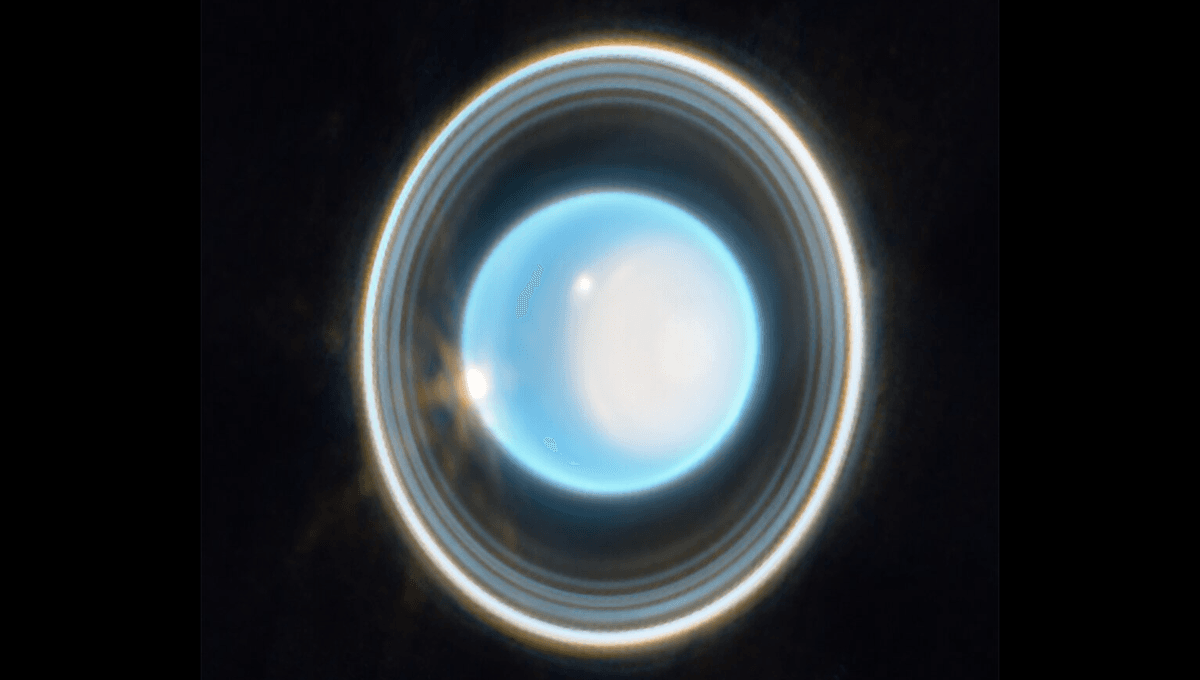
It’s almost forty years since Voyager 2 checked out Uranus, leaving some great mysteries behind. Three planetary scientists think they’ve shown two of these are connected – why its proton radiation belts are so weak and why its magnetic field is off-kilter – possibly solving one.
Magnetic fields affect the movements of charged particles, and a powerful field like the Earth’s causes high-energy particles from space to circle the planet. The interaction of particles from the solar wind and Earth’s magnetic field produces the Van Allen Belts (those things Moon landing deniers claim cannot be crossed by living things), protecting the atmosphere in the process.
Other planets with magnetic fields have similar belts, but Uranus and Neptune’s magnetic fields are weird. In the case of Uranus, it is tilted almost 60 degrees from the planet’s axis of rotation, unlike those of Earth, Jupiter, and Saturn, which are much more aligned. It’s also not centered near the middle of the planet, but rather a third of the way to the south pole. Voyager 2 reported the magnetic field is strong, but the radiation belt is weak. Imperial College London PhD student Matthew Acevski and colleagues argue that’s partly because of the decentered nature of the field.
Using the Boris algorithm, a method to calculate the movements of charged particles, Acevski and co-authors tested how the asymmetrical magnetic field should affect the behavior of protons that become captured. They found that the field asymmetry causes particles to move at different speeds while circling. Protons build up at locations where they move slowly and spread out where their movement is faster.
“This is analogous to how traffic jams form on a ring road. When cars travel slower, it causes more dense traffic; if cars travel faster, the traffic is more spread out,” Acevski told Space.com.
Since Voyager 2 did not orbit Uranus, but only checked it out on the way past, the authors suspected it’s not so much that the radiation belt is weak, but that our only visitor happened to measure a depleted area.
The team modeled where the protons would move faster and slower and concluded Voyager 2 passed through an area of depletion.
Notably, the effect only really applies to protons. Electrons’ masses are so much lower that their paths are barely altered by the asymmetry, consistent with Voyager 2 reporting a strong electron radiation belt.
As neat as this is, the authors acknowledge their work doesn’t explain measurements as low as Voyager 2 made. “It is possible that with the inclusion of more complex system dynamics this effect compounds to be a more significant contribution to this deficiency,” they write.
If the proposed Uranus orbiter comes to fruition, the unexplained portion of the weakness may be one of the easier mysteries to solve, but whether this will happen while Mars Sample Return consumes most of NASA’s exploration budget is uncertain.
Neptune’s magnetic field is almost as angled as that of Uranus, but Voyager’s measurements of its proton radiation belt were strong. Whether this difference is real, or a consequence of the areas Voyager 2 passed through remains to be seen.
The study is published open access in the journal Geophysical Research Letters.
[H/T Eos]
Source Link: The Radiation Belt Of Uranus Isn't Weak, It's Just Lopsided